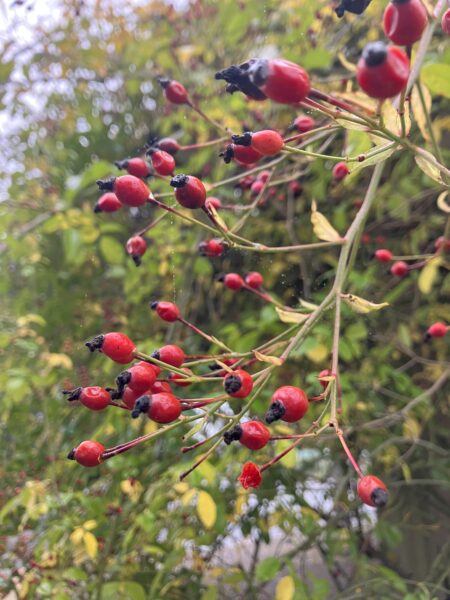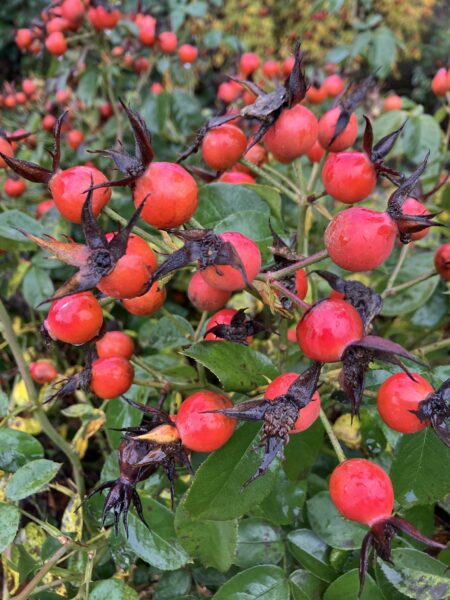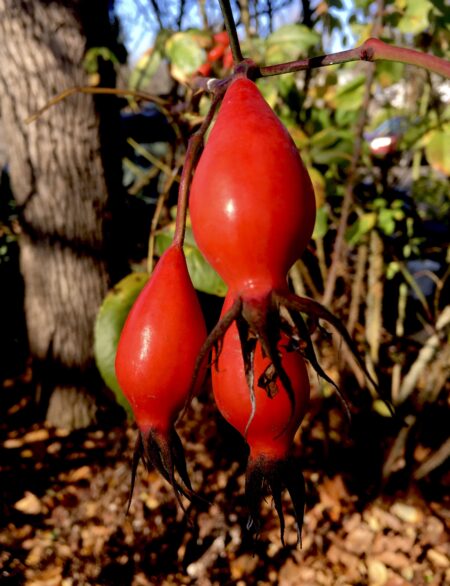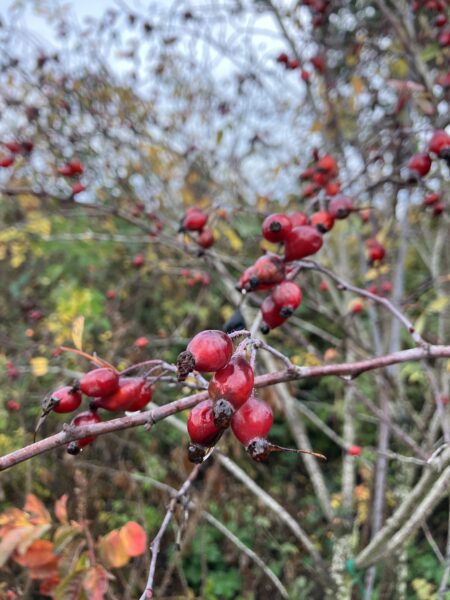Cedar Waxwing’s Autumn Song to Rosehips
November 19, 2023

I flock with my fellows,
on November gusts
we glide,
guided by memories of
last year’s feast—
sweet,
seeded,
and plentiful.
We descend together
and sing our piercing songs
to the bounty
of rosehips
red and bite-sized.
My dusky tail feathers
spreading squared and wide,
colored stormy sky
with yellow tip—
a sunbeam
through the gloom.
And my tawny wings
wear a wax-red flash
to please the fruit,
a compliment
to rosehip’s shine.
They hang clustered,
high in the treetop,
low in the bush,
in the tangle,
the shelter,
the home of resting hummingbirds,
and tail-flicking squirrels.
Rosehips
in my beak,
in my sight,
my smell,
my whole world,
my umwelt,*
red, sweet,
fortifying.
Then,
a motion,
smear of red,
and I cock my head.
Who’s below,
moving remnants
of our feast
with crumple of white
on reflection of glass?
Human,
why do you flap
your featherless wings
across your sleeping machine?
Do you scavenge rosehips
with rags?

Rambling up the Oregon Ash tree in my hellstrip, Francis E. Lester, a rose I planted some twenty years ago, is home to this Cedar Waxwing Thanksgiving feast. Throughout the year, Francis is an eye-catching, nose-pulling, skin-snagging wonder. But, this month it’s all about his hips! They red-speckle overhead branches and the windshield of my new truck alike.
I wrote about roses before. Blame it on growing up in Portland, City of Roses, cutting my teeth on the floral abundance of the International Rose Test Garden.
Now, though, after years in the field, it’s the wilder roses I admire most. Like a well-aged wine, maturity brings refinement. And the most refined roses are not the buxomly petaled darlings. No, they’re wild, or, at least, closer to it. They’re free to the pollinating fervor of bees, free to form nutritious red fruits. Single or semi-double blooms with open centers connect to the ecology of your garden, attracting not only your admiring gaze, but the more-than-human life that buzzes and flaps and animates the scene.
Our Pacific Northwest native hip-bearing roses include:
The tall, hedge-forming Nootka rose (Rosa nutkana). Give her the space to spread, to thicket, to grow into songbird shelter. Her large hips come early and hang on through winter, offering Vitamin C-rich bounty to birds and industrious jam-makers.
Nootka’s smaller hipped relative, the cluster rose (Rosa pisocarpa) is a perfect alternative to overly-complicated French drains. Plant her in that wet spot in your garden. Problem solved, elevated even with beauty and life.
For your woodland garden, let baldhip rose (Rosa gymnocarpa), the most petite of our natives, delight with it’s tear-drop hips that are free from the jester cap floral remnant others of its kin wear.

To expand beyond native roses and still enjoy a good showing of hips in the fall, choose varieties that have fewer petals so they can be successfully pollinated. Bees have a hard time getting into cabbage-full blossoms. Those plants are fantastic for our noses and vases, less so for the small creatures of the garden.
And remember to stop dead-heading early enough to allow the flowers to progress to fruit. Heirloom Roses nursery in St. Paul, Oregon, has a fantastic selection of own-root plants, which means they’re not grafted and you don’t have to worry about pruning root stock suckers. Their website has filters where you can select “roses with hips”.
Besides the rambling ‘Francis E. Lester’ that delights my Cedar Waxwing guests,
Disease-resistant roses with hips that I’ve grown and loved include:
‘Lyda Rose’, a compact and very fragrant seedling of ‘Francis E. Lester’. (No, not a seedling of my Francis!)
‘Darlow’s Enigma’ will equal ‘Francis E. Lester’ in vigor, transforming your old shed into a refuge for bees and birds.
‘Sally Holmes’ is fantastic large shrub for a moon garden with her generous, five-petaled blooms in barely-blushed white. She’ll continue to bloom with deadheading, but holster those shears in August or September to get hips.
‘Playboy’ is for you fiery color lovers. With blooms that glow in summer gardens and reliable hips in fall, this is one is real hottie.
Rosa rugosa’s hips are sometimes called sea tomatoes. Cute, right? It makes the best best bird hedge near the coast or inland.
Rosa glauca is a designer’s favorite with dusky-blue leaves and magenta star flowers, transforming into clusters of red hips that hang onto leafless autumn branches.

Choosing a rose for its hips as much as for its flowers will expand not only its potential season of interest in your garden, but also it’s allure for berry-eating birds.
*umwelt : I learned this term from Ed Yong’s book An Immense World. It describes the sensory environment which makes up one’s entire world, one’s sense of reality, one’s experience of their “self-centered world”.
